Factsheet
Britain's Rare Flowers
Explore the UK's rare flowers, each section gives ideas about what you can do to help to protect them.
Rare Flowers of Meadow and Cornfield

About 5,000 years ago the earliest people in Britain, the Neolithics, began to clear the vast forest which covered most of the country. They used the trees for fuel and the land for cultivation. Then, in 500 BC the Celts arrived and with their more sophisticated agricultural techniques began to create fields for crops and meadows for cattle. These new habitats provided homes for many flowers such as fat hen, good King Henry and black bindweed. When the Romans arrived they probably introduced more cornfield ‘weeds’ such as corn marigold, corncockle and scarlet pimpernel in the supplies of corn which were imported to feed the legions. The fields were once rich with flowers; perfect conditions were created for them by the constantly disturbed and well-fertilised soil of arable land.
However, our agricultural activities have changed over the years. Seed-cleaning and selective weed-killers, designed to kill the ‘weeds’ which compete with the crop, have made some flowers very rare. Even the once common red field poppy and blue cornflower are under threat. Meadowland flowers have also suffered from intensive farming, especially over-grazing. The word meadow actually means a grass field that is not grazed until after the hay is brought in. Rare meadow species include the fritillary, spiked speedwell and meadow saffron.
Here are three examples of our once common flowers:
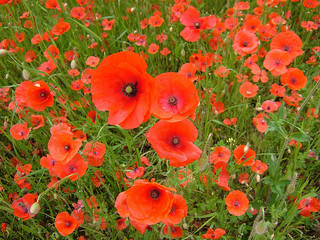 Field Poppy Papaver rhoeas
Field Poppy Papaver rhoeas
Poppies were associated with cornfields in ancient times. Ceres, Roman goddess of corn, was depicted wearing a wreath of field poppies.
People once used parts of the poppy to cure various aches and pains.
The flower is a well-known symbol of Remembrance Day; it was growing on the fields of Flanders after the battles of the First World War.
Poppy plants are 20-60cm in height and they flower from May until October.
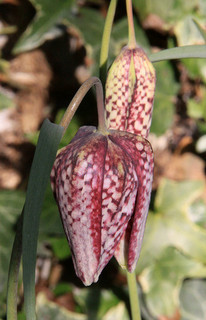 Fritillary Fritillaria meleagris
Fritillary Fritillaria meleagris
In the early 20th Century the chequered purple flowers of the fritillary were common in wet meadows, but draining, ploughing and fertilisers have greatly reduced the areas where they can grow.
Magdalen Meadow in Oxford is famous for its profusion of wild snakeshead fritillaries. The owners have never allowed cattle to graze it in spring, but have instead harvested the haycrop in mid-summer. This allows the flowers to grow undisturbed and set seed for the following spring.
The plants are 20-50cm in height and flower in April-May.
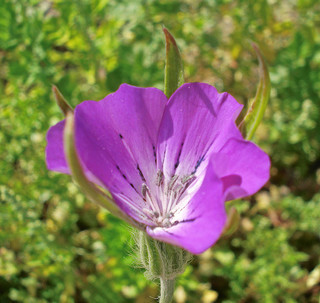
Corncockle Agrostemma githago
The flowers of the corncockle have undivided petals and are reddish-purple. It was once a common cornfield weed but the seeds are poisonous to humans in large quantities, and so if they become mixed with corn they lower the quality of the flour. Improved agricultural techniques have made this pretty flower very rare.
The plants are 30-100cm in height and appear June-August.
Things to do:
1. Look up the three examples in an illustrated wild flower book, print the fact sheet, and try to draw the flowers with pencil crayons.
2. Make a list of the other wild flowers mentioned in this topic sheet. Look them up in a book and find out more about them, making your own notes and diagrams.
3. You can help to save these wild flowers from extinction by growing them yourself! Many garden centres now sell seeds or young plants of several of Britain’s native wild flowers, or a mix of wild flower seeds so that you can create your own mini-meadows and beds of cornfield flowers.
Please never dig up wild plants or collect their seeds – this isn’t helping to conserve them and it’s illegal.
Rare Flowers of the Woodland

For about 7,000 years, following the end of the last Ice Age, nearly all of Britain was covered with forest, mostly consisting of broad-leaved trees, oak and elm being the most common species. Then, as iron tools were developed, people began to clear the forests for cultivation and permanent settlements. Over the next 4,000 years or so, techniques advanced, particularly during the roman and Saxon times, and vast areas of forest were destroyed. Most of the remaining forest disappeared during the 16th and 17th centuries to provide timber for boats or charcoal for the iron industry.
During the 19th and 20th centuries, even more of our woodlands were cleared and as a result many of the plants that grew in them have become extinct or rare. Very few of the scattered woodlands date back to prehistoric times. Most have been replanted at some stage and poorly managed. The commercial conifer plantations e.g. pine, common in Scotland, do not provide enough light for ground plants to flourish. Natural pine woodlands are more open, with clearings which allow foxgloves etc. to grow. Some of the most successful broad-leaved woodlands today are those managed by private estates as pheasant reserves.
In spring, the typical British woodland floor is carpeted with bluebells, primroses, celandines, lords and ladies and, sometimes, wild daffodils. These attractive flowers are certainly not as plentiful as they once were and, unless you are the land-owner, it is against the law to collect them.
Here are just three examples of our once common woodland flowers:
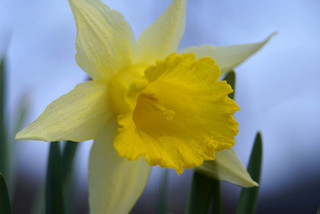 Wild Daffodil Narcissus pseudonarcissus
Wild Daffodil Narcissus pseudonarcissus
Carpets of delicate yellow daffodils in damp woods and grasslands were once a common sight in springtime. Drainage, pasture improvement, woodland clearing and people digging up bulbs have all contributed to its decline.
In the 17th century the daffodil bulbs were used as a medicine for various ailments. Ground-up bulb mixed with barley meal was used to aid the healing of wounds.
The single-flowered stem is up to 36cm in height and it flowers from February until April.
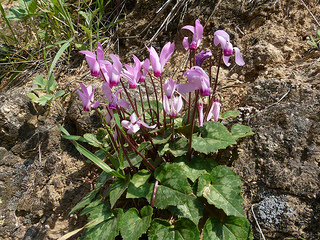
Cylamen Cyclamen hederifolium
Some woodlands in Kent are probably the only places where the cyclamen is still a wild plant. There are many types of cyclamen in gardens but it is rare in the wild.
The plant is 10-30cm in height and it flowers from August until September.
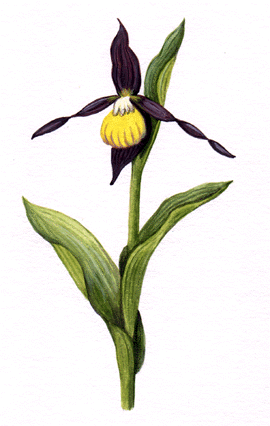 Lady’s Slipper Cypripedium calceolus
Lady’s Slipper Cypripedium calceolus
This orchid has large striking flowers quite unlike those of any other British orchid. It is one of Britain’s rarest species. A few plants grow at one carefully protected site in Yorkshire.
The plant is 13-45cm in height and it flowers from May until June.
Things to Do
1. Look up the three examples in an illustrated wild flower book and draw the flowers with pencil crayons.
2. Five other woodland flowers are mentioned on this fact sheet. Make a list of them and find out more about them, making your own notes and diagrams.
3. Perhaps you and your school can help to save some of the disappearing woodland plants.
It is quite easy to create a mini-woodland habitat either in your garden or the school grounds and grow a few wild flowers. It’s possible to buy seeds or young plants of native woodland flowers e.g. primrose, bluebell, daffodil, etc, at garden centres. Never dig them up from the wild or collect their seeds! Why isn’t this a good idea?
Wild flower gardening can be a very rewarding pastime – and you’d be doing Britain’s flowers a good turn too!
Rare Flowers of Chalk Grassland

Nearly all the grassland, or downlands, of modern Britain are artificial habitats, created by man’s destruction of the forests. Neolithic people began to cut down the vast forests about 5,000 years ago, followed by the Celts and Romans, and they mainly concentrated on cultivating the lighter soils and higher ground. Cattle and sheep were grazed on the South Downs at this time, preventing them from reverting to woodland. When the Anglo-Saxons, using eight-ox ploughs to turn heavy clay soil, cleared many of the valleys, much of the farmland of the chalk and limestone hills was abandoned. Beech woodland took over the cultivated ground in many places but elsewhere sheep continue to graze, keeping the land clear of trees. Thus the chalk and limestone grasslands were formed.
Many plants depend upon lime for their growth. The soil on grasslands is shallow and the porous rocks below allow rain to drain away quickly. The main plants are grasses which form a short, springy turf. Typical flowers include many species of orchid, including the unusual bee orchid, cowslip, common milkwort and mountain pansy.
Several of the colourful grassland flowers have become very rare through human activities – mainly habitat destruction and digging up of plants. Remember to take care when walking on downlands: young plants are easily damaged when trodden on and a lot of trampling may compact the soil, preventing seeds from germinating.
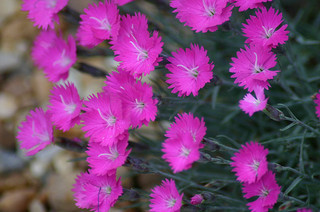 Cheddar Pink Dianthus gratianpolitanus
Cheddar Pink Dianthus gratianpolitanus
One of Britain’s rarest flowers, the cheddar pink is now fully protected. It is found only on the cliffs of Cheddar Gorge, Somerset. For years it was picked and dug up by collectors. The cheddar pink has large flowers which appear April-June.
The plant is 10-12cm in height.
 Spring Gentian Gentiana verna
Spring Gentian Gentiana verna
A dense cushion is formed by a rosette of the spring gentian’s lower leaves. The flowers are a rich, deep blue. This plant is only found in Yorkshire, Durham and Cumbria at altitudes of 366metres and above.
It is 2.5-15cm in height and flowers April-June.
 Pasqueflower Pulsatilla vulgaris
Pasqueflower Pulsatilla vulgaris
The flowers of this close relative of the anemones are large and violet-purple. It grows among grasses on dry, chalky slopes from Gloucestershire to Essex. The height of the plant is 10-30cm and it flowers April-May.
Things to do
1. Look up the three examples in an illustrated wild flower book and draw the flowers with pencil crayons.
2. Draw an outline of the map of Britain and mark all the present-day stretches of chalk grassland. Mark the spots where the three examples can be found.
3. Four other grassland flowers are mentioned on this fact sheet. Make a list of them and find out more about them, making your own notes and diagrams.
4. Some of our rare native flowers are commercially grown and can be bought from garden centres. If you are interested in gardening it’s a good idea to try creating your own mini-downland habitat – perhaps your school would be interested too. This is a very practical way to help prevent Britain’s beautiful flowers from becoming extinct.
Credits
Image: Rare Flowers by tdlucas5000

 Field Poppy Papaver rhoeas
Field Poppy Papaver rhoeas Fritillary Fritillaria meleagris
Fritillary Fritillaria meleagris


 Wild Daffodil Narcissus pseudonarcissus
Wild Daffodil Narcissus pseudonarcissus
 Lady’s Slipper Cypripedium calceolus
Lady’s Slipper Cypripedium calceolus
 Cheddar Pink Dianthus gratianpolitanus
Cheddar Pink Dianthus gratianpolitanus Spring Gentian Gentiana verna
Spring Gentian Gentiana verna Pasqueflower Pulsatilla vulgaris
Pasqueflower Pulsatilla vulgaris